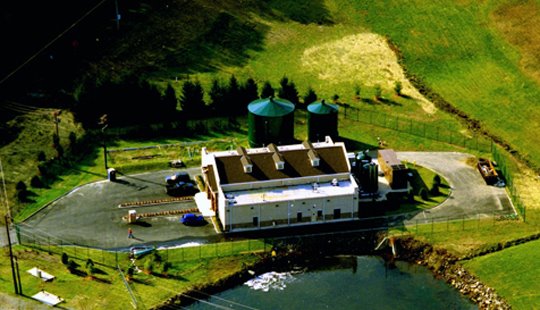Opportunity
In 1935, a water treatment system was built to treat water from the Clyde Potts Reservoir to provide drinking water to residents of Morristown, NJ. The reservoir was considered relatively pristine, and treatment was limited to chloramination and pH adjustment using lime.
In 1984, the Southeast Morris County Municipal Utilities Authority (Authority) responded to new turbidity standards by constructing a direct-pressure filtration plant on the site. In 1998, in response to even more stringent drinking water standards, the Authority constructed a 0.5 million gallon per day (MGD) membrane treatment plant as a demonstration project.
Despite the advanced technology, the membrane plant was unable to remove tastes and odors from the source water. The plant did not achieve its rated capacity, and the chemical intolerance of the cellulose-acetate pressurized membranes led to high rates of fiber failure and higher than anticipated staffing needs and operational costs.
Solution
The Authority retained Mott MacDonald to undertake a detailed evaluation of the membrane demonstration plant and a feasibility analysis for the incremental expansion of the plant. We also performed pilot-scale testing of alternative membrane systems and compared costs for incremental flows up to 2.5 MGD.
Mott MacDonald recommended the existing system be abandoned, and proposed a new immersed-membrane treatment system.
We were retained to complete the design of the new 2.5 MGD plant, which includes the following:
- Two trains of GE Zenon’s Immersed Zee-Weed membrane filters
- Granular activated carbon for removing taste and odor compounds
- Chemical storage and feed systems for membrane cleaning, corrosion control, and disinfection
- Residuals disposal facilities
- Residuals, permeate, and high-lift pumping systems
- Emergency power
Outcome
The new plant was the first to use membranes in New Jersey and was placed into service in November 2004. After almost a decade of operation, the plant has met or exceeded all of its performance and operating goals. The permeate pumps, reject pumps, strainers, and aeration blowers are all operating and have not been replaced.
Each of the 288 membrane modules contains 2,700 fibers. In the first three years of operation, no fibers were repaired. In 2008, about 200 fibers were repaired in a single module. As of October 2013, 123 or 43% of the original modules were still in service. According to the warranty, only 10% of the modules were expected to remain in service by then.
The granular activated carbon system has proven effective in removing tastes and odors. In order to protect the adjacent high-quality local trout-fishing stream, and because the site has no sewers, the plant was designed to obtain a recovery of 80%. Clean-in-place wastes are neutralized in the membrane tanks and the neutralized waste is pumped to two steel storage tanks that were part of the original pressure filtration plant.
The collaborative efforts of the Authority’s operations and management staff, working in conjunction with Mott MacDonald, led to a treatment system that has met the Authority’s operational expectations and water quality goals and objectives.
Mott MacDonald's John Civardi and the Authority’s Paul Kozakiewicz described their experience in a paper called “Built to Last: A Review of 10 Years of Performance of New Jersey’s First Microfiltration Plant.” The paper, presented to the American Membrane Technology Association (AMTA), was nominated for our Best Paper of 2014 award.
Mr. Edward Taratko, PE served as an Authority board member throughout the planning, design, construction and operation of the facility. He used his knowledge to assist the Authority staff and the design engineer in many aspects of the project including: selection of the optimum membrane system, optimizing the layout to be compatible with the unique site constraints, and reducing the vulnerability of the facility to flooding.



